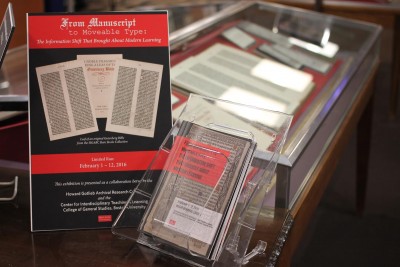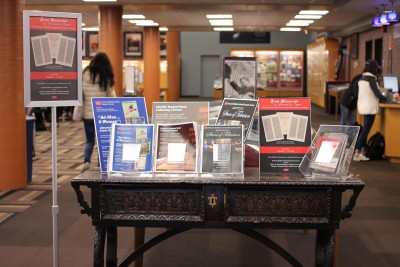
Texts produced with the printing press as early as in the ninth century have impacted modern education, as demonstrated by an exhibition of archives opened Monday at the Gotlieb Memorial Gallery.
“From Manuscript to Movable Type: The Information Shift that Brought about Modern Learning” features a vellum leaf of a hymnal manuscript dating back to between the ninth and 10th century and a leaf from the Gutenberg Bible, believed to be “the single-most important and famous printed book,” from the year 1454. The exhibit will be on display on the first floor of Mugar Memorial Library until Feb. 12, according to the exhibition’s page on the Howard Gotlieb Archival Research Center website.
Lydia Fash, a lecturer in the College of General Studies and curator of the exhibit, said the display’s purpose is to allow students to reach their own conclusions about the shift in modern learning.
“The exhibition aims to invite students into the historical moment,” Fash said, “and to introduce them to the past conditions that help form a piece of writing, encourage them to make interdisciplinary connections [and] correct some of the faulty assumptions of our digitally-saturated world.”
William Shakespeare’s “The Comedy of Errors” from the First Folio, the first full collection of his plays published in the year 1623, and a leaf from the 15th-century Book of Hours, “a devotional manual used by laypeople from the thirteenth century to the sixteenth century” were also exhibited.
With only four items on display, the exhibition is not considered a large collection of archives. However, Fash said, it showcases a few critical items that are evident in history.
“The exhibition isn’t large,” Fash said. “Each item, as I explain in an accompanying booklet, can tell us much about both print history and the shift to modern learning.”

Sean Noel, associate director of the HGARC, said the exhibit is a first-time collaboration between the HGARC and the Center for Interdisciplinary Teaching and Learning at CGS.
“The exhibition represents the importance of collaboration and our support of interdisciplinary study at BU,” Noel said. “We hope our students are impressed and inspired by the artistry of these historic treasures.”
Undergraduate students assisted in preparing the artifacts displayed as part of an internship period through a course in the College of Arts and Sciences, Noel said.
“Our exhibitions coordinator, Christopher Gately, prepared the items,” Noel said. “He was assisted by students who are part of the CAS Internship program run by Linda Wells. It is exciting that CAS undergraduates had the opportunity to work with these amazing items.”
Several students said they were interested to see the display, as the impressive inventory is a valuable resource for students.
Jose Esqueda, a senior in CAS, said the four objects in this exhibition are important historical artifacts and should urge students to pay more attention to current exhibitions.
“The display is incredible,” he said. “It’s kind of a historical achievement and it seems like people and students aren’t really appreciating it, because I hadn’t heard about until recently.”
Jackie Amaro, a junior in CAS, said exhibitions like these could further garner students’ interests in historical documents.
“It’s really cool and interesting that [the HGARC] is displaying stuff like that on campus since students don’t really become interested in the exhibition until they see it,” she said. “It’s a cool installment to put up, especially because it is displayed in a place where all students pass by and can look at.”
Charles Evans, a senior in the College of Engineering, said he’s interested in learning more about archives currently exhibited.
“This is really the first I’ve ever heard of the display,” he said. “It’s amazing that they have these transcripts. I don’t see why I wouldn’t go see it at some point.”


















































































































